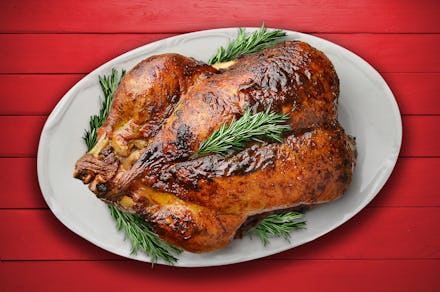Experts share unconventional — but ingenious — tips for cooking Thanksgiving dinner

Whether you’ve been cooking Thanksgiving dinner for three decades or are hosting your first, there’s always something new to learn. Mic recently met with a group of Thanksgiving experts from Butterball, which has hosted a Thanksgiving helpline called Turkey Talk-Line since 1981, to learn some of the unconventional tips they’ve collected over the years of turkey therapy.
The following Thanksgiving dinner commandments, which include advice from Butterball and a few other experts, should make your dinner a lot less stressful — and a lot more delicious.
Provide an answer to the question, “What can I bring?”
When your guests inevitably ask what they can bring to your festive gathering, give them an answer that would actually be helpful to you. It’ll be mutually beneficial: People like the feeling of being needed, and you’ll have one less item on your to-do list. The pros over at the Kitchn suggest requesting things like dessert and booze, two party mainstays that can easily be purchased or made without much kitchen skill (love you, Betty Crocker). If you have a vision for your menu, don’t ask for appetizers or side dishes, since your guests won’t be able to read your mind.
Make your own roasting rack.
Any turkey recipe will instruct you to position the bird on a roasting rack before putting it in the oven. If you cook the meat directly on the pan, the bottom will likely burn and the rest of the meat will be dry and chewy. Because no one wants those results, but not everyone has a roasting rack, the turkey virtuosos at Butterball suggest crafting your own rack out of tin foil. To do this, transform a few sheets of aluminum foil into rings — or coils of foil, as Butterball calls them — to serve as a platform for the turkey. So long as the turkey is raised up off the bottom of the pan, you’re golden.
Set up your ironing board.
Hopefully you’re not doing laundry at the same time you’re cooking Thanksgiving dinner. Set up your ironing board in the kitchen, or nearby, and voila — you’ve got extra counter space. This ingenious trick earned Food52’s “gold medal kitchen hack” title in 2012, but remains practical to this day. Just make sure your board is sturdy, and definitely don’t put it in a place where rowdy pets or people will be hanging around. Cover it with a table cloth if you’re feeling fancy.
Surrender the baster.
Basting is pointless labor, according to experts at Butterball. Shocking to hear, perhaps, except when you consider the fact that a turkey’s thick skin renders it virtually waterproof. Instead of unnecessarily basting, consider a dry rub (some will fall off but will still flavor the drippings) and adding seasoned butter underneath the skin. You could pop some herbal butter into the freezer and slice it into thin discs when solid, then scatter it underneath the turkey’s skin beforehand or while the bird’s in the oven. Freezing the butter will keep your hands from getting messy while you add the flavor.
Don’t fear the deep-fried turkey.
You might consider the deep-fried turkey the ultimate indulgence. But, as it turns out, its nutritional content doesn’t differ much from an oven-baked bird. “There is no difference fat/calorie-wise between breast meat without the skin cooked in a fryer or in an oven,” Sue Smith, director of the Butterball Turkey Talk-Line, said in an email. If the majority of your party craves a deep-fried bird, health-conscious guests can rest easy, knowing that without the skin, the nutritional stats are about equivalent to a conventional turkey. Learn how to deep-fry one here.
Craft a turkey lifter.
You could be the strongest person in the world, and transferring a cooked turkey from its roasting pan to a serving plate would still be difficult. The move requires stillness, a sturdy hand and sometimes just good luck. Butterball’s experts suggest making a turkey lifter out of kitchen twine. They explain how in the simple illustration above, and here’s a handy video if you’re still stumped.
Carve alone.
Carving table-side may be a family tradition of sorts, but the activity can be stressful (and dangerous) in front of a crowd, Butterball experts said. The pros recommend assigning guests with a task outside of the kitchen — be it filling water glasses or setting up sides — while the carving goes down. No audience means more precision and no over-eager fingers intruding for an early taste.
Never refrigerate a whole cooked turkey.
There’s nothing wrong with prepping your turkey a day in advance with plans to heat it up on the big day; in fact, Butterball’s gurus said this can be a great move for saving time and oven space. But shoving the whole bird into your fridge poses the risk of dry meat — a true Thanksgiving nightmare. Instead, separate the breast, legs and wings, and reserve some of the cooking juices to pour over the meat while you heat it the next day. The juices will help the turkey achieve a desirable moistness. You could also carve the turkey entirely — just as you would to serve — and refrigerate overnight. You’ll want to save juices for this technique, too.
Wash and dry your knife as you carve.
You may be tempted to carve your bird in one fell swoop, but the Butterball connoisseurs said that the cutlery is guaranteed to get gooey and slippery, which can increase the risk for accidents: Knife injuries are among the reasons why emergency room visits spike on turkey day. You’ve waited 364 days for this event, what’s an extra 10 careful minutes to ensure there’s no human blood in the entrée? You can carve the turkey by the sink for easy access or keep a damp kitchen towel nearby, while alternating between carving and knife-wiping.